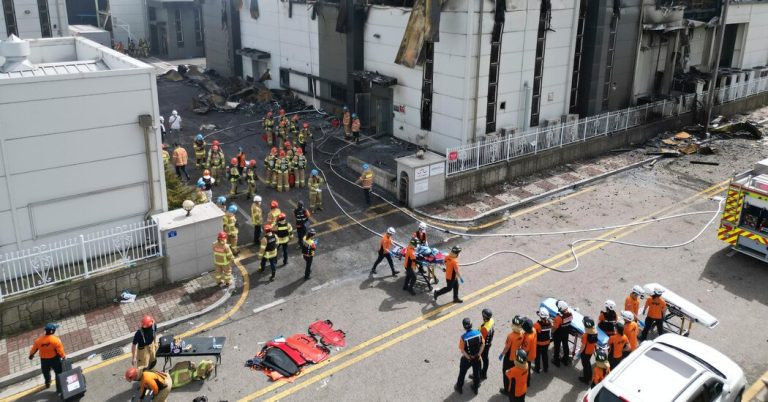A fire at a lithium battery factory near Seoul on Monday killed 22 workers, most of them migrant workers from China, in one of South Korea’s deadliest fires in years, officials said.
Officials said rescuers were still searching the building in Hwaseong, 28 miles south of Seoul, for a worker who had been reported missing. They said it was unclear if the worker was in the building when the fire broke out.
Two workers were taken to hospital with serious injuries. Six others were slightly injured.
Kim Jin-young, an official with the Hwaseong Fire Department, said 102 people were working at the factory, owned by battery maker Aricell, when the fire broke out. The 22 victims include 18 migrants from China and one from Laos, as well as two South Koreans.
They were found dead on the second floor of the 12,500 square foot factory. The floor had two unlocked exit staircases leading outside, but workers appeared to have been engulfed by flames and toxic smoke before they arrived, Mr Kim said.
The Chinese, including Koreans, are the largest group of migrant workers in South Korea. Of the 523,000 foreigners who visited South Korea on temporary work visas, according to government data released late last year, more than 100,000 were from China.
Separately, hundreds of thousands of Korean Chinese work in South Korea on special longer-term work visas that the country grants to Koreans living abroad.
After decades of low birth rates, South Korea is increasingly dependent on migrant workers to fill jobs that locals shun. Many farms and small factories in industrial cities like Hwaseong could not function without such migrant workers.
Workers who fled the fire said it started when a battery cell caught fire, causing a series of explosions among some of the 35,000 lithium battery cells stored on the factory’s second floor, according to Mr. Kim.
Fires can occur in lithium batteries when the internal layers are compressed, causing a short circuit. The layers can be compressed by a sudden impact, such as during a vehicle crash, or by the gradual swelling of batteries through regular use.
Lithium is a metal that can store large amounts of energy in a small space, which is why it is attractive as a battery material. But this also means that there is a lot of energy available to turn into heat and even flames in the event of a short circuit. Lithium battery fires are a growing problem in the United States and elsewhere, and fires are an industry-wide concern for battery manufacturers.
Aricell, the owner of the Hwaseong plant, makes batteries often used to run power grids and other utilities.
Intense flames, toxic smoke and the risk of further explosions hampered efforts by firefighters to search for the missing workers on Monday. Television footage of the fire showed large flames and thick clouds of smoke billowing from the factory. Footage taken after the fire was extinguished showed the building gutted, with its roof caved in.
More than 160 firefighters, along with 60 fire engines, rushed to contain the fire. President Yoon Suk Yeol called on his government to “mobilize all available human resources and equipment.”
The fire was the deadliest in South Korea since a fire at a construction site southeast of Seoul killed 38 people in 2020.
Although South Korea is known for its cutting-edge technology and manufacturing, the country has long been plagued by man-made disasters, including wildfires.
In 2018, nearly 50 people, most of them elderly patients, died from toxic smoke inhalation in a fire at a hospital that had no sprinklers. In 2017, 29 people were killed in a fire at a gym and public bath complex. In 2008, 40 workers—including migrant workers—died in a fire at a cold storage facility under construction.




